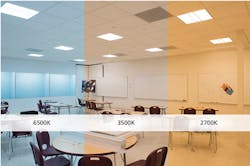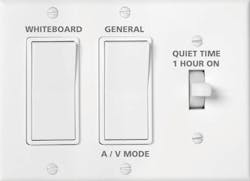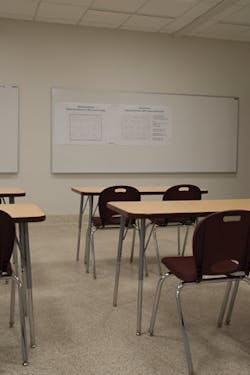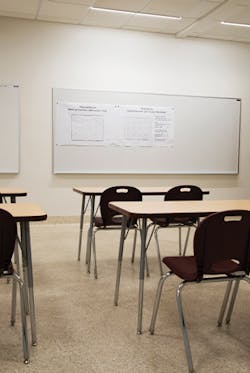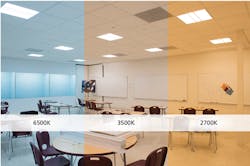A conversion to LED-based solid-state lighting will of course reduce energy and maintenance costs for schools, says TERRY CLARK, but implementing tunable lighting and controls will increase the savings impact as well as enhance the learning environment for years to come.
"Everything we thought we knew about lighting has changed over the past five years," Jerry Mix, CEO of Finelite, likes to say. "The sources, the energy requirements, the controls, lifetime, efficacy, color options, form factors - everything!" And he is correct. LED technology has pulled lighting into a dimension with several exciting new opportunities and many emerging cutting-edge developments.
Interested in articles & announcements on tunable white lighting?
The biggest challenge affecting lighting decisions today is future proofing. Choices made today will likely have an impact over the next 20 or perhaps even 40 years.
For example, we can expect the best LED lighting available today to maintain 90% of initial light output for 100,000 hours or more. Compare this to a fluorescent lighting system that needs regular maintenance after only 30,000 hours due to lamp burnouts.
The simple act of choosing an LED system over a fluorescent one alone can begin to reduce lifecycle costs by saving future maintenance costs.
However, the choice of LED over fluorescent is just the beginning. Let's look at other future-proofing decisions that should be considered when choosing your next lighting system.
Future-proofing basics
The concept of future proofing a space is especially relevant for educational facilities, where public and private investment carry an expectation of longevity and valuable service to children, young adults, and the community at large over several generations. The goal is to specify state-of-the-art systems set in place now that are flexible enough to maintain all their value (by meeting the needs of educators and the community) for decades.
Every future-proof lighting system should create and maintain value for students, teachers, and the school district.
Basic future proofing creates value for teachers by enhancing the teaching experience, and it is cost effective and easy to implement.
FIG. 1. Classroom wall controls give teachers flexibility. (Source: All images courtesy of Finelite.)
These are the must-have basic concepts that add immediate value to the teaching experience:
• Lighting controls built specifically for teacher activities
• Switching modes to support better viewing of projector and media devices
• Vertical lighting of classroom surfaces (white boards)
• Dimming down to 10%
Education has moved from a predominantly lecture-oriented style to a more multi-faceted approach. Activities range from independent projects to small groups and student-led presentations. These are in addition to traditional lecture-style teaching. All of this often happens in a single classroom, within a single day.
Lighting controls built specifically for teaching support collaborative learning and technology in the classroom.
Classrooms have moved well beyond the on/off switch at the door. In 2007, Finelite conducted research on classroom lighting for California and New York State. The published findings have been used by the Collaborative for High Performance Schools (CHPS) and LEED (Leadership in Energy and Environmental Design) to develop best practices for classroom lighting.
Now, Finelite has been joined by other manufacturers in supplying systems with distinct modes for white boards, audiovisual systems, group activities, test-taking, and tablet usage. While there may still be a toggle switch at the door, these more granular controls have been relocated to where the teacher is centered, usually at the nominal front of the classroom (Fig. 1).
These controls add vertical lighting on teaching surfaces to improve visibility and direct student attention. They also support a teacher's need to act in the moment while maintaining the attention of the class.
Classrooms have become more flexible, and we see that learning takes place everywhere. Bean bags in the corner and sofas under the windows invite small group discussions. Desks and tables are moveable for more fluid classroom layouts. New technologies abound: multiple white boards and writeable walls; flat-panel displays; tablets and handheld devices; streaming and interactive content; group audio-visual presentations; and video conferencing.
FIG. 2. Typical classroom setting with general illumination using tunable white technology (left) and with illumination set for optimal whiteboard viewing (right).
Future-proof lighting provides switching and dimming modes that help direct the attention of the students; these modes also improve the viewing of projector content, computer screens, and media devices (Fig. 2).
Creating value for teachers
Cutting-edge concepts that are likely to become the standard in the classroom of the future include: color tuning; using lighting to cue behavior and lesson plans; ensuring color quality with high-CRI lighting; delivering 1% dimming; and providing app-controlled lighting for teachers.
More recently, Finelite, in a project with the US Department of Energy (DOE) and RTI International, is taking flexibility one step further by testing the feasibility of tunable-white LED lighting in the classroom (http://bit.ly/2dcknog). The project takes into consideration cost, efficacy, lifetime, controls, and comfort. Results are expected be published in late 2016 or in early 2017, but it is worthwhile to examine the performance criteria and goals that were established.
The DOE/Finelite/RTI project is focused on the suitability of two-source tunable white for educational facilities, where cost, energy efficiency, and longevity are as important as flexibility, comfort, and the emerging science related to lighting's impact on our circadian system and its implications for education.
Two-source tunable-white LED light employs pairs of LED chips-one cool and one warm-that are blended to produce a range of white light that can be easily controlled.
The DOE established the following requirements for the lighting and controls: luminaires must be energy efficient (120 lm/W); the teacher must be able to control intensity and CCT; daylight and electric light must be balanced; control is both local and central; and both vertical and horizontal illuminance levels are used to ensure excellent quality light.
Teachers have been using light intensity to control behavior for some time now, for example, flicking the on/off switch to get students' attention or dimming the lights to calm them down. Tunable white technology adds color temperature to this equation (Fig. 3). Researchers are still working to quantify the impact of CCT on behavior, but, as Naomi Miller, a research scientist at Pacific Northwest National Lab, has observed, "whiter, bluer lights in higher intensities may tend to wake us up, and lower, warmer colors may tend to calm us down...".
Teachers need to focus on teaching, so controls have to be close at hand, intuitive, and undisruptive. To aid in this, Finelite will provide several ways to define intuitive user interfaces, with icons for "presentation," "calm," "energize," "white board," and "group work." Color-coded sliders are another option.
We have also found that teachers are highly individual with their own teaching style. Some use AV extensively, others encourage student-led presentations, while some may place a strong emphasis on group work. As such, lighting needs to be customizable. Finelite has developed an app for iOS and Android devices that can enable teachers to create a set of lighting preferences that will accompany them to different classrooms throughout the day.
Creating value for school districts
Basic future proofing saves money and improves learning experiences for students and staff. Schools will need guidelines to get started - and installing LED lighting systems is the first step. They are affordable, save energy, and reduce maintenance costs.
LED technology uses less energy and requires less maintenance, improving lifecycle cost compared to fluorescent technologies.
Choosing a quality LED lighting system that lasts decades is critical; it should be virtually maintenance free and warrantied for at least 10 years.
Lighting design is just as important, and best practices include ceiling lighting and vertical lighting to improve the lighting quality and save energy by delivering the most efficient light in the right places.
FIG. 3. Tunable white LED lighting allows flexibility in educational spaces, future proofing the classroom for a variety of uses and audiences.
Using this approach can cut lighting power densities in half compared to current energy codes. Energy savings can be further increased with occupancy sensors, daylight sensors, and basic dimming controls.
Cutting-edge concepts further extend the functionality of a lighting system. Methods to improve system management include advanced trim settings, scheduled lighting cues for tunable white light, and networked lighting that is controllable from the central office or district level and allows for system interoperability. All of these factors can impact the management of appropriate lighting levels in classrooms, simultaneously saving energy and extending the life of the system. Furthermore, a tunable lighting system can be designed to provide circadian entrainment of students to school schedules that are not in sync with the natural solar day. (For more on circadian entrainment, see LEDs Magazine's recent feature on circadian lighting in the healthcare environment.)
The average age of schools in the US is 44 years, and the average age of significant renovations in schools is almost 20 years. As we learn more about the impact of CCT on health and behavior, institutions that invest in tunable white now will be ready to face the future.
MORE ON CLASSROOM LIGHTING
You can learn more about tunable-white and networked lighting for educational environments at ledsmagazine.com. We recommend the following articles on technology and implementation.
Need light? Try an IT company, like Mobile's school district did
Acuity launches tunable LED products for schools and offices at LFI
Philips Lighting launches indoor, tunable-white LED lighting platform
TERRY CLARKis founder and chairman of Finelite, Inc. (finelite.com).
